Feeling at home under the hood
by Tracy Kalytiak |
Katie Woodward has always worked with her hands. As a child, she liked blocks and other toys she could build things with. Cars fascinated her.
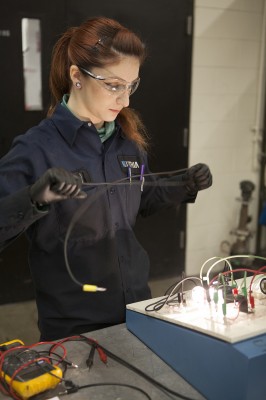
Katie Woodward works on a headlight circuit during an automotive technology class at UAA. (Photo by Philip Hall/University of Alaska Anchorage)
"When I was 9, I helped my uncle and my grandfather when they did tire repairs, oil changes, replaced a starter, worked on an alternator," she said. "They loved teaching me anything they could. Later, my friends would always ask my opinion with repairing a vehicle, what was wrong with the vehicle through its sound and feel."
Now, at age 20, Woodward is taking classes in UAA's Automotive Technology program that will move her toward earning an Associate of Applied Science degree. "I've always had a pretty strong pulling toward the automotive field and was set on going to this program from day one," she said. "I'm learning skills I can hold onto and use for the rest of my life."
One program, many facets
UAA's Automotive Technology program moved into its current facility in 1973. It provides courses for people seeking to become auto technicians and required training for working technicians.
Individuals may choose to earn an undergraduate certificate, which prepares a student for a career in automotive maintenance and repair, or an occupational endorsement certificate that provides more specialized knowledge in, for example, automotive electrical, brakes or power trains.
A student may also earn an Associate of Applied Science in automotive technology degree through taking general automotive classes, GM's Automotive Service Educational Program (GM ASEP) or Ford's Automotive Student Service Educational Training (ASSET).
The four-semester programs incorporate a prearranged, supervised, evaluated practicum in each of their first three semesters. Students may also move on to receive a Bachelor of Science degree in technology. That degree includes a capstone project incorporating their automotive expertise with, for example, creating highly detailed business plans and budgets for establishing a repair shop.
"One of them proposed a system for streamlining operations at the auto-repair facility where he worked," GM ASEP assistant professor Darrin Marshall said.
Kelly Smith, director of UAA's Transportation & Power Division, says the certification and degree options constitute one program with different levels. They do not have separate curricula and they share resources, making it possible to keep the program cost-efficient while offering a variety of academic options to students.
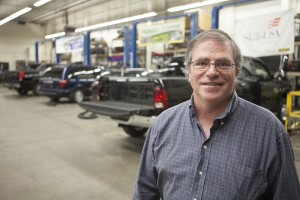
Kelly Smith serves as director of UAA's Transportation & Power Division, which runs automotive technology classes. (Photo by Philip Hall/University of Alaska Anchorage)
"The curriculum for academic programs in automotive technology is developed to provide students with a foundational knowledge first, with additional courses building on that foundation to build expertise in the discipline," Smith said, adding that people sometimes confuse academic certificates with industry certification. "Continuing education courses in the field are developed with an assumption that the student already has a foundation, and are usually aimed at providing in-depth knowledge of a specific system."
Forging productive partnerships
UAA's Automotive Technology program has cultivated mutually beneficial relationships with auto manufacturers and dealerships that save money for the university and enhance the quality and career relevance of the education students receive.
• GM donates late-model vehicles to UAA for students and working technicians to train on, helping GM and its dealerships keep their technicians' skills current and fill job vacancies with university-trained mechanics familiar with GM vehicles.
• Dealerships provide curriculum advisers, as well as internships automotive students must have as part of their degree and certification requirements-and they often extend job offers to UAA automotive students.
Woodward entered a UAA GM ASEP class in August. Auto technicians must earn National Institute for Automotive Service Excellence certification, which enables them to offer tangible proof of technical expertise. Woodward needs to have two years' experience in a shop to earn that ASE certification, so she is doing coolant flushes, changing oil and decarbonizing engines in the lube bay at Chevy of South Anchorage.
"It gives you a sense of accomplishment when you fix something that's important to someone else," she said.
Infusing an industry with fresh talent
The first "Check Engine" light-a little feature tucked into the dashboard of a 1980 Cadillac Eldorado-marked the birth of computers as diagnostic tools in American cars and trucks. That light also marked the beginning of a decline for a profession many people-primarily men-had first learned from their dads, their oily hands tinkering with socket wrenches on the family car, in the garage at home.
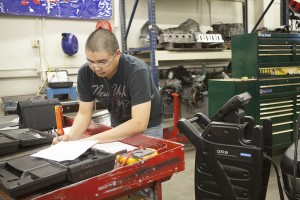
Chris Converse works on a test during his GM Automotive Service Educational Program class at UAA. (Photo by Philip Hall/University of Alaska Anchorage)
"Over the next two or three years, I saw people looking for a way out," Smith said. "Not so much the younger beginning technicians at that point, but the guys who had been around for a while, saying, 'I can't figure this out.'"
Thirty-five years later, mechanics who stayed in the profession are getting older, approaching retirement age. Car dealerships, independent auto repair businesses, body shops and a host of other businesses seek skilled auto technicians, yet there aren't enough trained mechanics available to fill 2,500 unfilled jobs GM has stated it has in its dealerships nationwide. The U.S. Department of Labor projects a shortfall in mechanics (and related occupations) of nearly 10,210 per year.
The problem is that cars are now wildly sophisticated, containing engine control modules and infotainment systems and delicate sensors that relay information about such things as excess oxygen and loss of tire pressure, and control the trajectory and velocity of air bags.
"Staying current with the rapid technology changes in the automotive world takes a true desire and constant dedication," Marshall said. "I love that my job never gets stagnant. I love the challenge of teaching students from the first semester to the last, and in between each semester, teaching GM technicians about the latest technologies. Teaching a student is tough, but an instructor better be on his 'A' game when you get a technician in class. I never want to have a technician ask me a technical question that I don't know the answer, or at least know where to find it."
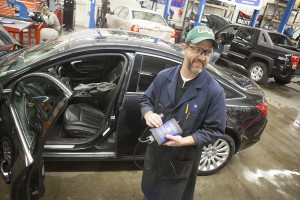
Darrin Marshall shows off a multiple diagnostic interface during an automotive technology class he teaches at UAA. (Photo by Philip Hall/University of Alaska Anchorage)
Kelly Smith said the profession is no longer about getting greasy and tearing parts apart, figuring them out and putting them back together.
"We need to be recruiting people into the industry who maybe wouldn't have been attracted to it when I started," Smith said. "You need to understand what's really going on or you're not going to be successful. There are a ton of opportunities across the board, especially automotive, and other industries that understand the transferable skills automotive technicians have."
Aspiring auto technicians at UAA spend as much time in the classroom as in the garage, learning to calculate horsepower, torque, volume of cylinders, displacement, compression and gear ratios and tolerances inside an engine. They learn about resistance, voltage and amps and how to properly use a scan tool and laptop software to navigate the intricate pathways of a car's diagnostic computers to find problems that keep a car from operating the way it should.
It's difficult to get and keep auto technicians who have training that integrates the rigor of a classroom with the industry relevance of hands-on experience, said Randy Carlson, service manager of Anchorage Chrysler Dodge Jeep Ram Center, who maintains close ties with UAA's automotive technology program by serving on its advisory committee.
Dealerships covet aspiring auto technicians who choose to take classes at UAA because getting academic training demonstrates their commitment and maturity, he said.
"They spent their money to get this training compared to someone who comes in from the street with a toolbox and used to change mom's oil," Carlson said. "They understand the finer points of this business."
'This has been totally awesome'
Randal Smith got his first dirt bike when he was 13 years old. When it broke, he took it apart and sent the motor out of state.
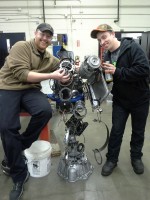
Randal Smith, left, and Daniel Locke show off a transmission sculpture they made. (Photo courtesy Darrin Marshall)
"In the meantime, it was all in this box," he said. "My neighbor told my parents, 'That's a shame you guys spent all this money on a bike and it's in a box. He's never going to ride that again.'"
Three days later, that dirt bike was out of that box and back on the trails. "I always had a knack for that," he said.
Fast-forward 10 years, when Smith and his friend moved from Colorado to Alaska on a whim. They rented a house and found jobs. Smith worked as a roofer. He liked the exercise, working hard outdoors, but on 15-below days he thought about finding something else to do.
"I wanted something more long term, stable, not weather dependent," he said.
In 2012, Smith enrolled in UAA's GM ASEP classes and, with the recommendation of his instructor, Darrin Marshall, found a job at Chevy of South Anchorage. In his classes, Smith enjoyed learning the theory of how electricity works and how electrical systems control the other systems in a car. At work, he saw how those theories work, in real life, in a car.
"At Chevy of South Anchorage, they paired me up with a seasoned electrical guy, an ASEP graduate, and I found out electrical is a lot harder hands on than it is on paper," Smith said. "I've made a few mistakes here and there, but over the last year and a half I've become more proficient. If it were up to me, I'd do electrical all day, every day. It keeps your brain working as opposed to just your hands. There are 25-30 computers in a car that control different things. If you can excel in the electrical aspect of an auto, you can go anywhere, walk into any shop. You don't have to ask for an interview-you interview the shop."
Smith has participated in SkillsUSA competitions, one of the first automotive students to do so. He took a gold medal in the Alaska state competition and earned ninth place nationally in a field of 52 competitors.
He also enjoyed Marshall's fiendishly difficult "Transmission Sculpture" exercise: a team of students takes apart a transmission and creates a sculpture another team must disassemble and then reassemble into a working transmission.
"It wasn't just a challenge to put together; it was a challenge to see how far we can take it apart," Smith said. "In this case, we wanted to challenge the other team, take these tiny pieces apart even further-even one-way roller clutches and sprang clutches. A shop wouldn't go this far taking a transmission apart."
Smith will receive his associate degree after completing two more classes: technical writing and introduction to business. He's now working at Alaska Sales & Service-Valley, in Mat-Su, but wants someday to work on his own.
"Ultimately I want to open my own shop, work for myself, get the benefits of being an entrepreneur," Smith said. "Going through this program at UAA has given me the tools to do it. This has been totally awesome-by far one of the best things I've ever done."
Written by Tracy Kalytiak, UAA Office of University Advancement
 "Feeling at home under the hood" is licensed under a Creative Commons Attribution-NonCommercial 4.0 International License.
"Feeling at home under the hood" is licensed under a Creative Commons Attribution-NonCommercial 4.0 International License.














